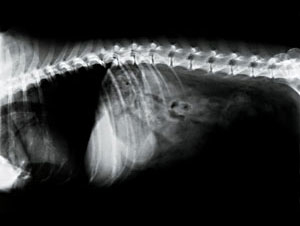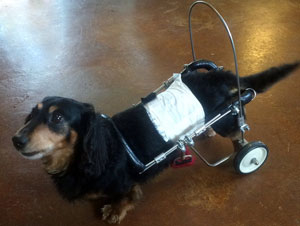Veterinary Spinal Manipulation Therapy
The practice of spinal manipulation therapy (i.e. chiropractic) involves the relationship between the nervous system and the spinal column and the critical role this relationship has in the maintenance of overall health. The nervous system is responsible for initiating and coordinating all signals of movement by stimulating the muscles that are attached to the skeletal system. The bones of the spine are maintained in a specific alignment via the joint surfaces that connect one vertebra to the next. The nerves exit the spinal cord between these vertebral joint articulations. If there is a misalignment (also referred to a subluxation), then the surrounding nerves, connective tissue, muscles, blood vessels, and lymphatics become affected, resulting in pathology or dysfunction.
Considering that the nerves are responsible for carrying information from the brain to the targeted muscles, tissues and internal organs, one can understand that problems can develop if the nerves lose their ability to function normally. If there is chronic hypomobility, adhesions can develop within the articular surfaces, which further support this subluxation complex. Considering the spinal columns intimate relationship with the nervous system, spinal manipulation therapy can also affect the health and function of internal organs.
Subluxations of the spine can result in the animal compensating by having unusual postures or movements which may help them avoid pain. This over-compensation can result in strain on adjacent joint surfaces leading to secondary subluxations in other areas, further affecting the animal’s overall health. Spinal manipulation can help restore range of motion and reduce pain, increase the animal’s flexibility and performance and, therefore, improve their quality of life.
A chiropractic adjustment is defined as a low amplitude, high velocity thrust that is directed at a specific articulation to correct a vertebral subluxation. One primary goal of an adjustment is to work on gapping the joint which will assist in the break down of joint adhesions, promoting more appropriate vertebral alignment and, therefore, restoring surrounding nervous tissue metabolism and function. A spinal manipulation examination includes a complete physical as well as neurological examination, stance and gait analysis and motion and static palpation. If areas of hypomobility are identified, an adjustment is performed and the areas are reevalauted for improved motion. Adjustments can also be applied to the jaw and extremities if indicated.
What are common indications for spinal manipulation therapy?
- Neck, back, leg and tail pain
- Muscle spasms, muscle atrophy and nerve problems
- Injuries from trauma or exercise
- Bowel, bladder and internal medicine disorders
- Maintenance of joint and spinal health
- Behavioral changes (aggression)
- Unexplained muscle twitching
- Unexplained lameness
- Lower levels of performance
- Excessively tight muscles
- Difficulty chewing
- Reluctance to jump or use stairs, ignoring commands Degenerative arthritis
How often are adjustments performed?
The number and frequency of adjustments is determined on a case by case basis. Chronic conditions will likely require more frequent adjustments before the body can begin healing itself. Initially it may be recommended that your pet be adjusted 1-4 times monthly in order to achieve realignment. Older patients often need longer times to heal and acute cases often respond in a more timely manner.
What can one expect after an adjustment is performed?
Many animals will show immediate improvement, while others may require a few adjustments in order to improve range of motion and resolve symptoms of pain. Sometimes pain medications like an anti inflammatory are indicated as tissue manipulation can result in some local inflammation and discomfort. Ensuring adequate water intake is recommended as well to promote hydration and normal cellular metabolism. Some animals may become tired for short periods of time after an adjustment.



